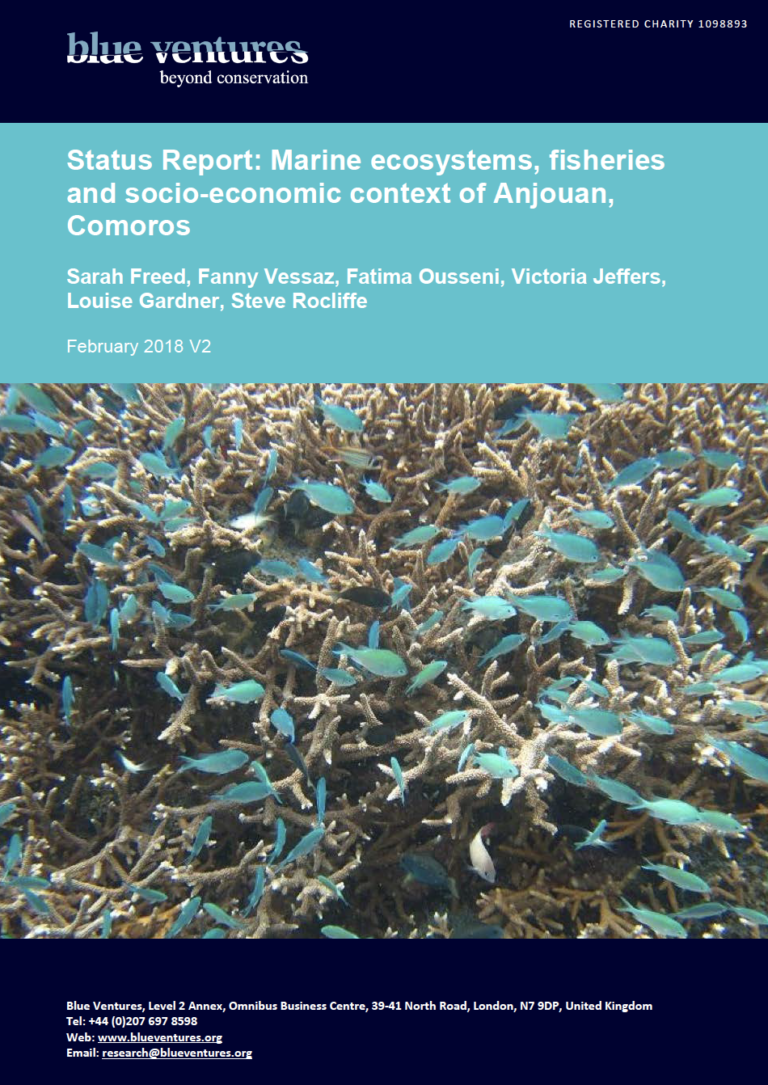Executive summary
The outstanding marine biodiversity of the Comoros islands is both poorly studied and subject to high local pressures on resources, especially on the island of Anjouan. In partnership with Comorian NGO Dahari, Blue Ventures aims to address the pressures on the marine ecosystems of the Sima peninsula in western Anjouan (Figure 1), whilst meeting the needs of fishery-dependent communities and conserving the marine resources and biodiversity. To achieve this goal, we need to identify and implement community-centred opportunities for enhancing conservation, fisheries management and livelihoods. However, there are little existing data available on the local ecosystems, socio-economic context or fisheries to inform these activities, so it was necessary to carry out broad-scale baseline research. Our programme of participatory research began in 2015, and we present the initial results in the report as follows:
● Broad overview of coastal ecosystems across the region of our interventions (coastal ecosystem mapping, 3.2.1)
● Broad overview of evidence of anthropogenic pressures (3.2.2)
● Detailed evaluation of coral reef status at several sites in the region (3.2.3)
● Broad overview of the socio-economic context across the region of our interventions (4.3.1)
● Detailed socio-economic assessment of the communities involved in our interventions (4.3.2, 4.3.3, 4.3.4, 4.3.5)
● Results of ongoing catch monitoring carried out at two of the sites involved in our interventions (5)
Key findings:
● There is vast coral reef coverage around the Sima peninsula, though live hard coral cover and fish abundance and richness varies widely.
● Mangroves are present in few locales, but cover appears to be stable.
● There are significant areas of seagrass bed on reef flats.
● Anthropogenic pressures are present, including fishing, erosion and sedimentation, beach excavation and household waste, with varying severity of pressures throughout the intervention region.
● The reefs at intervention sites of Mlongo Muhu (Bimbini) and Hadongo (Vassy) are in relatively good condition with coral cover between 34% and 65% depending on depth.
● The level of infrastructure across the intervention region is basic, and the coastal population depends heavily on fishing for income and food security.
● A total of 22,745 kg of catch was sampled across two sites, with catch per unit effort being lower in Vassy than in Bimbini (1.6 vs 2 kg/fisher hour). Bimbini’s fishery is large (many fishers) and widespread (many fishing locations), while Vassy’s fishery is relatively small and local.
● Local fisheries target pelagic and reef species using a range of techniques; in Bimbini fishers primarily use nets and target reef species, while in Vassy fishers primarily use hook-and-line methods and target pelagic species (especially tuna).
The majority of this baseline information has been fed back to the communities involved in our interventions and will be incorporated into locally led discussions on ways to manage marine resources and conserve marine biodiversity. Data collection is ongoing, and this report will be updated when the next set of analyses are complete.
Keywords:
Anjouan, Comoros, community-led fisheries management, rapid reef assessment

















